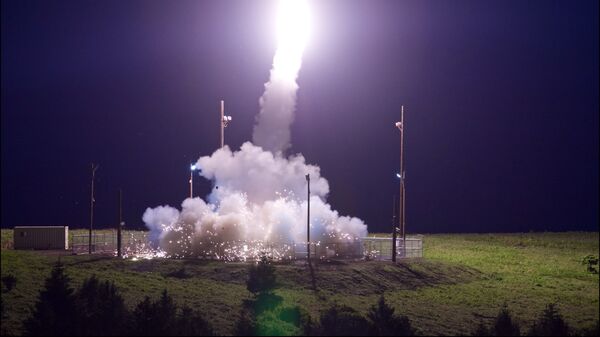For medium-range threats, the US and allied partners rely on Lockheed Martin’s easily transportable Terminal High Altitude Area Defense (THAAD) System. A THAAD system stationed in Kodiak, Alaska, successfully thwarted a ballistic missile launched from Hawaii, the MDA said in a Tuesday announcement.
The ballistic missile was launched from a Boeing C-17 Globemaster US Air Force aircraft, the agency said.
“I couldn’t be more proud of the government and contractor team who executed this flight test today,” Lt. Gen. Sam Grieves, director of MDA, noted.
“This test further demonstrates the capabilities of the THAAD weapon system and its ability to intercept and destroy ballistic missile threats. THAAD continues to protect our citizens, deployed forces and allies from a real and growing threat,” the director remarked.
The Pentagon’s missile specialist agency said THAAD has intercepted intended targets 14 times out of 14 attempts. US President Donald Trump retweeted a Fox News video following the test, claiming “US INTERCEPTS ANOTHER MISSILE” in all capitals.
The Aegis ballistic missile defense system aboard guided missile destroyers also purports take out ballistic missiles mid-flight, according to MDA.
While Aegis and THAAD are designed specifically for downing intermediate range ballistic missiles, the Pentagon’s long-range ballistic missile interceptor, the ground-based missile defense program, has had a far worse record.
The ground-based missile defense (GMD) system has been scrutinized for intercepting just 50 percent incoming missiles. What’s more, the Pentagon has gone through extended efforts to cover up the program’s incompetency.
A Los Angeles Times investigation found that Pentagon contractors took pains to claim problems hampering the interceptor’s thrusters didn’t exist. Missile defense experts told the Times that 34 of the Pentagon’s 37 interceptors have defunct circuit boards that can throw the interceptors off their flight path in mid-air. “One out of four [thrusters] failed in tests” conducted in 2016, former Pentagon testing chief Phillip Coyle told the paper. “I don’t think anybody should whitewash that.”
A Pentagon spokesman said “no corrective actions are needed,” however, for the multi-billion dollar GMD program.
The government’s own GAO added in a 2016 review: "GMD flight testing, to date, was insufficient to demonstrate that an operationally useful defense capability exists; and a quantitative assessment of GMD’s operational effectiveness is currently not possible.”




